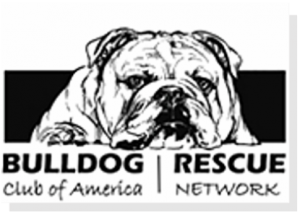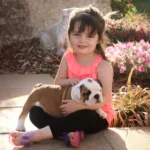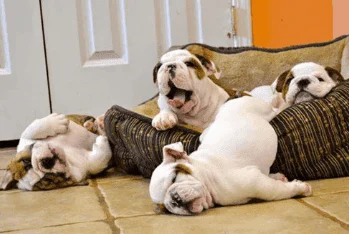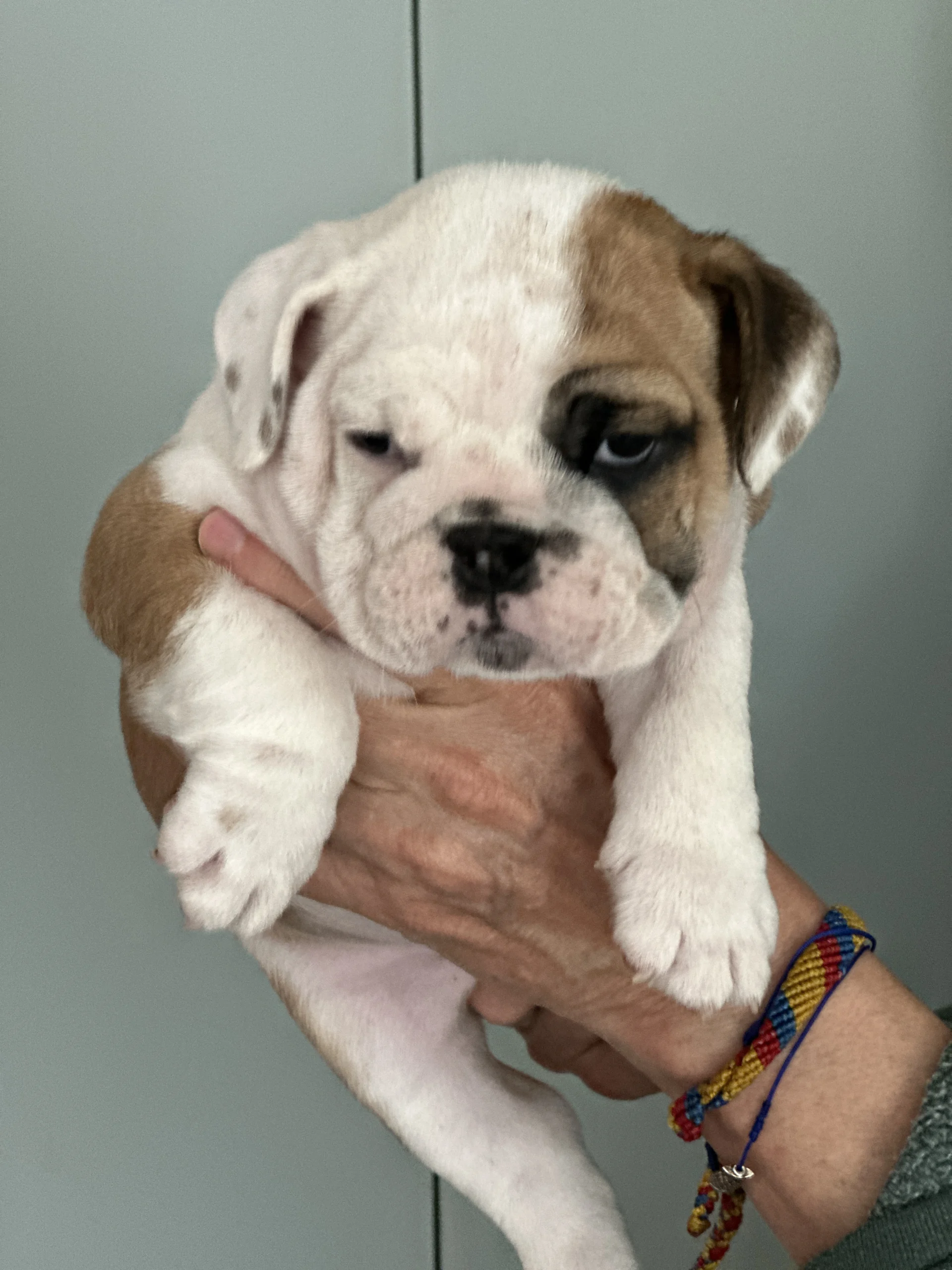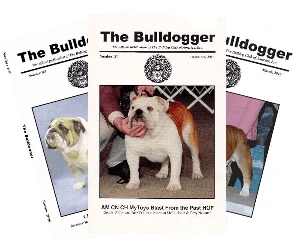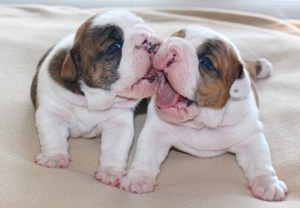
What to look for in a puppy
The dog should smell sweetly. Of course, if other puppies are present, there may be a smell of feces in the area where they are kept. However, unless the puppy has just stepped out of its food dish (which is very possible at the ages you will be looking at), a clean coat not only reflects health, but the quality of care the puppy has been given.
Above all you want a dog that acts healthy. A listless dog may have worms or an infection. An active and playful dog, with a good disposition, is what you want.
Of course, puppies still sleep a lot. Just because a puppy is sleepy doesn't mean it's not healthy, but you do want to see it awake and alert. It is not unusual for a puppy to struggle when picked up. Most young puppies will still playfully nip or chew on anything they can reach. However, if the puppy tries to bite you aggressively, it may not be a good prospect for a family pet. A too shy puppy, one who shrinks away from you or hides after time to get acquainted with you, may be hard to socialize into family life. Either may be fine, but be aware of the potential difficulties.
Please don't be discouraged if you don't get the pick of the litter. No one except the owner of the bitch usually does. The first puppy or two go to the owner (and the breeder of the bitch if it's the first litter on breeders’ terms). Second or third is about the best you can do if you are not involved in the breeding of the litter, even if you are already an otherwise experienced breeder. Of course, third can be exceptional. One local breeder's foundation bitch was third pick in her litter and she produced three champions in her only litter. You can see her traits carried down through the generations in their dogs. Similarly, a breeder did not keep a male who sired many exceptional Champions and is in the Bulldog Hall of Fame as a Top producer as a result.
If you are looking for a pet, consider an older dog or getting a rescue dog. An older dog may become available for many reasons. The owner may be moving and may not be able to take the dog along, the family's life style may have changed (a new baby, for example) and they can no longer spend the time with the dog that it needs, or the dog may have a problem (either health or temperament) that the family can't cope with. Many of these older dogs make wonderful pets for the appropriate owners. Find out why the dog is available and get to know it and see how it interacts with you. If it is a good match, both you and the dog may have lucked out.
All breeds need a vet familiar with the breed, so choosing a good one is crucial. Bulldogs require all the care that any other breed does. It is important as a dog owner that you become familiar with your dog's normal disposition and activity level, so you can look for early signs of illness. Bulldogs are a highly specialized, man-made breed that functions best in civilization, just as we do.
You won't experience in one dog all the problems discussed under Health Care. That list is designed to provide you guidance on recognizing specific issues, many of which are highly unusual. However, at some point all animals become ill or injured for a variety of reasons. As you learn more, you can recognize the problems and feel more confident in your ability to handle many of them yourself and to decide when a Vet needs to be called in.
Your Vet must be experienced in handling Bulldogs - the more, the better. It's worth traveling farther to see a Vet that sees many Bulldogs - they can diagnose and handle the breed better than a Vet who is less familiar with Bulldogs. This is important for everyday care. It is may be crucial if the dog has a major problem. For example, Bulldogs have more difficulty with anesthesia than other breeds because of their unique breathing configuration. A more experienced Vet will know when not to use anesthesia and how much to use when it's needed.
There are usually several experienced vets in the area and the local club or your breeder can help you in finding a Vet used by Bulldoggers in your area. BCA Members have compiled a litt of Vets they have found to be most experienced in Bulldog Care. Please consider using a vet you will find by visiting Finding a Bulldog Veterinarian. This list is provided as just one resource to help you in your efforts to provide the best care possible for your Bulldog. In choosing among Vets, try to find the best diagnostician; someone able and willing to explain what he sees, its implications and treatment options. You will need this to participate intelligently in the treatment of your dog. You should take the puppy to a Vet for an examination within the first few days you have him, preferably on the day you bring him home. The earlier the better, since you will want to be assured he is in good health and have your Vet tell you anything specific you should be doing. You should bring a stool sample with you, so your Vet can test for worms.
Prepare for the trip home. Read the sections under Safety and Safety found Here to make sure you are ready to safely house your puppy. You need to protect both your home and your puppy from unintentional harm before you pick up your new puppy. Your new puppy will be less secure when removed from the place it was raised, so your first task is to make that transition as pleasant as possible. You can either carry your puppy in your car in a crate or on your lap on the trip home. Each has its advantages and disadvantages.
The crate is safer, but more stressful for the puppy since it will not have contact with you on the trip. Your lap will be a more comforting place (probably for both you and the puppy), but is more dangerous in case of an accident or sudden maneuvers. Taking a favorite toy and/or piece of bedding with a familiar smell will help ease the trip whichever method you choose.The length of the trip home may influence your decision. The longer the trip, the more likely that the puppy will have to eliminate during the trip. To minimize this, make sure your new puppy has a chance to relieve himself before leaving the breeder's home. In any case, you should be prepared to deal with the situation if an accident occurs.
Your puppy may not be as interested in food as he is normally during his first day or two with you. He's nervous and excited - that's a normal reaction to a major change in his life and surroundings. Be patient with him and try priming his eating by giving him small tidbits of chicken or meat (really small is fine - you want to prime him, not have him teach you to hand feed him). Mix some tidbits into his food and then put two tablespoons on the top near the edge of the bowl. Hand feed him a piece he can see you take from the pile in the bowl and feed him over the pile in the bowl so he makes the connection immediately. Getting him to start this way should be easy and he should be eating normally in a day or two.
Try not to do distracting things while he's eating during this period. In a short while, you can go about your business when he's eating and he won't even notice. Water should always be available for the dog, either in the crate whenever he is confined or in the room. They make special bowls for water in crates to reduce spilling. Large, heavy, flat bottomed bowls are best outside the crate - they are less likely to spill and will be easy for your dog to drink from comfortably.
Food and water should always be placed in the same spot in the room where you feed him. It's less confusing for him and he can establish good eating patterns. Imagine how hard it would be for you if someone kept changing where the dinner table was. Toys should be available - puppies like variety and need to chew. Never use rawhide or cute soft rubber toys. They present choking hazards for Bulldogs. Nylabones, Kong toys or other similar hard chew toys will be safer for your dog and satisfy his need to chew, especially when teething.
Dogs like an area that's their own. Most breeders have found that a dog crate is ideal for giving the puppy a sense of security in his new surroundings and a place to retreat when tired. An open crate in a dog-proof room is a good place to keep the dog when you are out of the house for a few hours and can't supervise him - he'll get used to having the crate ready for a snooze and won't object to being in it when the door is closed. Don't feel that your dog won't like to be crated - he'll feel its home to him and be more secure there than roaming around. When you leave for work, just tell your dog to get in the crate and then calmly walk away from wherever they are to where the crate is.
Of course, you should make this pleasant for them by rewarding them (with praise or a tidbit) when they do this and by making sure toys and water were in the crate to take care of their needs. Never use being put in the crate as a punishment, although if the dog needs to be settled-down, you can use it as a pleasant (for you and the dog) "time out" space. If you don't plan to get graduated size crates for your puppy, a crate about 24" wide by 36" long by 24" high should be big enough for a large, mature Bulldog. You want a space that is big enough for him to stretch out, but small enough to make your puppy secure. Buy several rubber backed bathroom mats to use as crate mats. They can be either used alone or topped with an old blanket if you want additional padding. The blankets alone will not provide good footing - they have a tendency to slide in the crates. The mats can be washed frequently to reduce doggy odors and to ensure a flea free environment.
For the first few days, the crate should be in your bedroom to give the puppy company at night and increase his sense of security. Depending on his age, you can place a clock in his crate to suggest the sound of his mother's heartbeat (just remember to turn the alarm off) or can put a warm (not too hot) water bottle or plastic jug under the mats at one end of the crate to create the sense of warmth from other bodies. Some use puppy crates that can open from the top and put them next to the bed. That way you can leave your hand draped inside or reach in to quiet the dog. It soothes them and does not lead to dependence if you don't continue the practice more than a few days. After that, you can decide where you want him to sleep. Make sure his crate is in a room that can be closed off until he's very reliable. If there is too much commotion in the room with the crate, you can cover the top and sides with a cloth, provided there is enough air circulation and the dog won't overheat in the crate. If it gets warm, be sure that the air-conditioning is on or a fan it circulating the air.





